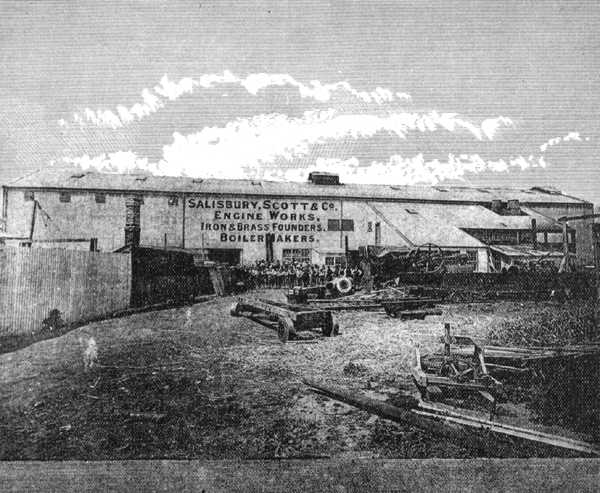 |
 |
|
Iron Founding and Metalworking Industry
The first significant iron/brass foundries and metal working facilities were established in Hobart by the partnerships of Henry Davidson (founder) and Alexander Clark (millwright) of the Derwent Foundry in 1840, and James Easby (millwright) and Robert Robertson (founder) of the Albion Foundry in 1844. Similar operations were established in Launceston by William Peter (founder) and William Knight (millwright, Phoenix foundry), briefly in partnership, and William Huttley (engineer/founder). Initially, foundries largely operated as import agents and repair workshops. Gradually they made larger implements, from stoves in the 1850s to large steam engines and substantial iron castings during the 1870s. Railways and the mining industry during the 1870s provided impetus for expansion. In under twenty years, achievements included boilermaking (1870, John Clark, Hobart), railway locomotive fabrication (1877, also John Clark), stamp battery and associated ore processing equipment (1877, Salisbury & Armstrong, Launceston), welded wrought iron box girders (1884) and rivetted wrought iron girders (1885, both William Henry Knight, Launceston). The latter enabled iron bridges, particularly for railway crossings of rivers and estuaries, to be fabricated locally. Railway maintenance facilities were established at Launceston in 1871 and Hobart by 1883, the latter including Hobart's only copper furnace. Knight installed reverberatory furnaces in 1885 to enable wrought iron to be re-worked, and in purpose-built plants at Mount Bischoff, Launceston and Hobart for tin smelting. Following the passing of the Inspection of Machinery Act (1884), Robert Kennedy & Sons established a marine engineering and maintenance facility including a slipway at Battery Point where an iron-hulled bucket dredge for use at the Mersey estuary was built in 1887. After remote areas in the north and west of the state were settled towards the end of the nineteenth century, rural foundries were built at Devonport in 1887 (Finlayson Bros), Latrobe in 1889, Zeehan in 1899 and Scottsdale in the 1900s. Foundries continued to come and go in the twentieth century, and some industries like the Electrolytic Zinc Works (1916) had their own foundry sections. As cheaper mass-produced fittings of plastic or other material (for example, pipes of plastic rather than cast iron) replaced metal, and many other metal components were imported, the number of foundries declined. Some have endured. Peter's Foundry, in 2004 Tasmania's largest, is the oldest continuously operating foundry in the southern hemisphere. It now trades as Bradken, strictly a ferrous foundry. Salisbury's in Launceston made the Cataract Bridge, and in the 1920s became a structural specialist rather than a foundry. Retlas, reputedly founded in Hobart in 1906 by a Mr Salter (the name is Salter backwards), has moved several times. In 2004 it specialises in marine fittings and industrial castings. During the Second World War, from 1942 munitions were produced at the Munitions Works in Glenorchy, which employed almost 1500 workers, and other foundries such as Peter's also assisted the war effort. A number of foundries were established after the war. Austral Bronze moved from the mainland to the old munition plant, and produced brass and copper components, but moved back to Sydney in 1964 when the price of freight rose too high. Bill Perkins and Selwyn Skeels founded Skeels and Perkins in the late 1940s, and by the 1980s produced bronze and aluminium castings, next door to Incat at Glenorchy. In 2004 the firm, still owned by the Perkins family, trades as Apco Engineering, and is unusual in that it works in both ferrous and non-ferrous metals. The Montpelier Foundry moved from Hobart to Glenorchy in 1949, and mostly made castings for large industries such as the Zinc Works and Mount Lyell. In 1974 a former employee, Rex Garner, began the Derwent Foundry, making bronze castings and propellers. Montpelier was sold to a mainland firm in the early 1980s, but in 1986 Garner bought it. The combined business is now called Derwent Pipelines. In 2004 half a dozen foundries continued to manufacture metal products in Tasmania. Further reading: M Morris-Nunn & C Tassell, Launceston's industrial heritage, Launceston, 1982–83; A Alexander, Glenorchy 1964–1998, Glenorchy, 1998. Keith Preston |
Copyright 2006, Centre for Tasmanian Historical Studies |
